11 Case Study 5: Case Study Comparing County Analyses of Inequities in Health Insurance using ACS vs. CDC PLACES data (2019)
By: Christian Testa, Dena Javadi
11.1 Introduction
The CDC PLACES dataset and American Community Survey (ACS) represent two distinct approaches to collecting and reporting on small area level data: the CDC PLACES uses a method called small area estimation (SAE) to produce estimates at the Census tract level, while the ACS provides survey based estimates directly at the Census tract level.
The methodology page from CDC PLACES provides further explanation as to exactly how they implemented SAE.
In their article Multilevel Regression and Postratification for Small-Area Estimation of Population Health Outcomes: A Case Study of Chronic Obstructive Pulmonary Disease Prevalence Using the Behavioral Risk Factor Surveillance System, Zhang et al. describe how SAE was performed to estimate
chronic obstructive pulmonary disease (COPD) in CDC PLACES.
11.2 Motivation, Research Questions, and Learning Objectives
The goal of this case study is to gain familiarity with the ACS and CDC’s PLACES, understand how SAEs are created, and visualize comparisons between SAEs. The outcome of interest in this case study is health insurance.
The specific learning objectives are to:
- Download specific ACS and CDC’s PLACES data
- Visualize (plot) and map estimates Characterize trends in the estimates by area based social measures (ABSMs)
- Understand limitations of SAEs Explore validity of model-based estimates
- Understand the effect of smoothing estimates in very small areas
Given that both CDC PLACES and the ACS provide estimates of the Census tract prevalence of health insurance, we are interested in assessing what difference there is between the two datasets and how that difference may vary according to ABSM.
11.3 Understanding Small Area Estimates
What is Small Area Estimation?
Goal: To provide finer geographic detail of published statistics for various subpopulations.
Problem: Surveys generally do not provide large enough samples for reliable direct estimates for small areas (counties, and especially census tracts).
Challenges: model misspecification and failure to account for informative sampling.
How valid and reliable are the PLACES county level estimates?
- Depends on quality of underlying data
- Depends on assumptions and appropriateness of statistical models used
- smaller uncertainty ranges for model-based estimates as compared to direct estimates
- smoothing out of local geographic variation which results in potentially underestimating small areas with high prevalence estimates and overestimating small areas with lower prevalence estimates
- higher discrepancies for behavior indicators than for diagnosed chronic diseases potentially due to different biases such as self-report or recall bias
Model based estimates are also not sensitive to local area interventions or shocks, meaning that prevalence may be over or underestimated based on prior trends without accounting for what local surveys may capture - such as a targeted local intervention or a disaster event. An example of this can be seen in Zhang et al’s study where model-based estimates of current smoking prevalence for two adjacent counties in Missouri were 24.2% and 25.0% while direct survey estimates from a local survey were 25.3% and 13.5% due to the latter county’s local tobacco control initiative.
What is Multilevel Regression and Post-stratification (MRP)?
Multilevel statistical modeling framework linking geocoded health surveys and high spatial resolution population demographic and socioeconomic data
To conduct MRP, we need:
- Surveys with outcome of interest, demographic data, and geographic indicator
- The geographic and demographic data will be used as predictors in the first stage model to define geographic and demographic levels for the second stage
- Continuous variables will need to be split into intervals to create levels
- Factors and levels must match those in the poststratification table (so individual level demographic and geographic variables must match population level variables)
What is a postratification table?
- Representation of the combination of demographic and geographic factors that correspond to the number of individuals in a population of interest
- The number of rows in a poststratification table would correspond to
the product of the number of options for each of the variables
included
- I.e. 6 age groups * 3 gender categories * 8 racialized categories * 50 states = 7200 rows
- First stage
- Multilevel logistic regression model
- Second stage
- Weight model predictions for each subgroup by population estimated frequency of these subgroups
- Considerations: missing variables for post-stratification table, nonresponse, missing data, inclusion of interaction terms (useful for studying demographic subgroups within geographic levels) and use of structured priors to share information across levels of a factor, violation of positivity assumption
11.4 Create our Cleaned Dataset
# dependencies
library(tidyverse)
library(magrittr)
library(tidycensus)
library(patchwork)
# get our data from PLACES
# download the county level data from https://chronicdata.cdc.gov/500-Cities-Places/PLACES-Local-Data-for-Better-Health-County-Data-20/swc5-untb
# rename it to "places_2021_release_county_level.csv"
places <- readr::read_csv("data/11-health-insurance-comparison/places_2021_release_county_level.csv")
# filter for our measure of interest
places %<>% filter(Measure == "Current lack of health insurance among adults aged 18-64 years")
# download ACS data
# remember you can check the variable table here:
# https://api.census.gov/data/2019/acs/acs5/variables.html
acs <- tidycensus::get_acs(
geography = 'county',
variables = c(
'total_population' = 'B18135_013E',
'with_disability_no_insurance' = 'B18135_018E',
'no_disability_no_insurance' = 'B18135_023E'
),
year = 2019,
state = c(state.abb, 'DC'),
geometry = TRUE,
output = 'tidy',
survey = 'acs5')
# recode the variable names
acs_cleaned <- acs %>%
as_tibble() %>% # as_tibble drops the geometry, which causes an error later with data manipulation
select(GEOID, variable, estimate, moe) %>%
mutate(
variable = recode(variable,
"B18135_013" = "total 19-64 population",
"B18135_018" = "uninsured 19-64 population, disabled",
"B18135_023" = "uninsured 19-64 population, not disabled"))
# pivot wider so we can do arithmetic with the columns
acs_cleaned %<>%
pivot_wider( # pivot into a wide format so we can do arithmetic with the columns
id_cols = GEOID,
names_from = variable,
values_from = c(estimate, moe))
# calculate rates of uninsurance and corresponding margin of error
acs_cleaned %<>%
janitor::clean_names() %>%
rowwise() %>% # rowwise is necessary for the tidycensus::moe_* functions to work correctly
mutate(
# calculate uninsured numerator
uninsured_numerator = (
estimate_uninsured_19_64_population_disabled + estimate_uninsured_19_64_population_not_disabled
),
uninsured_numerator_moe = tidycensus::moe_sum(
moe = c(
moe_uninsured_19_64_population_disabled,
moe_uninsured_19_64_population_not_disabled
),
estimate = c(
estimate_uninsured_19_64_population_disabled,
estimate_uninsured_19_64_population_not_disabled
)
),
# calculate proportion uninsured
pct_uninsured_19_64_acs = uninsured_numerator / estimate_total_19_64_population * 100,
# calculate moe for percent uninsured
pct_uninsured_19_64_acs_moe =
tidycensus::moe_prop(
num = uninsured_numerator,
denom = estimate_total_19_64_population,
moe_num = uninsured_numerator_moe,
moe_denom = moe_total_19_64_population
) * 100
) %>%
select(geoid, pct_uninsured_19_64_acs, pct_uninsured_19_64_acs_moe, estimate_total_19_64_population) # select only the columns we need
# select for the crude prevalence
places %<>% filter(Data_Value_Type == 'Crude prevalence')
# join the places and acs datasets
uninsurance <- places %>% full_join(acs_cleaned, by = c("LocationID" = "geoid"))
# rename to geoid for consistency
uninsurance %<>% rename(geoid = LocationID)
# extract the counties shapefile from what we downloaded from acs
county_sf <-
acs %>%
# it doesn't matter which variable is used here, we just have to make sure
# we only get one measure per census tract
filter(variable == variable[[1]]) %>%
# select just the GEOID so we get the GEOID and geometry
select(GEOID)
# join in the counties shapefile data
uninsurance <-
county_sf %>%
left_join(
uninsurance,
by = c("GEOID" = 'geoid'))
# clean the column names
uninsurance %<>% select(
GEOID,
Year,
StateAbbr,
StateDesc,
LocationName,
Data_Value,
Low_Confidence_Limit,
High_Confidence_Limit,
pct_uninsured_19_64_acs,
pct_uninsured_19_64_acs_moe,
estimate_total_19_64_population
) %>%
janitor::clean_names() %>%
ungroup() %>%
rename(
state_name = state_desc,
county_name = location_name,
pct_uninsured_18_64_places = data_value,
pct_uninsured_18_64_places_ci_low = low_confidence_limit,
pct_uninsured_18_64_places_ci_high = high_confidence_limit
)
# calculate confidence intervals for the percent uninsured
uninsurance %<>% mutate(
pct_uninsured_19_64_acs_moe_95pct = 1.96 / 1.645 * pct_uninsured_19_64_acs_moe,
pct_uninsured_18_64_acs_ci_low = pmax(
pct_uninsured_19_64_acs - pct_uninsured_19_64_acs_moe_95pct,
0
),
pct_uninsured_18_64_acs_ci_high = pmin(
pct_uninsured_19_64_acs + pct_uninsured_19_64_acs_moe_95pct,
100
)
)11.5 Visualizing the Data
# load our cleaned dataset
uninsurance <- readRDS(here("data/11-health-insurance-comparison/county_uninsurance.rds"))
# calculate the difference in the
uninsurance %<>% mutate(
difference_in_acs_minus_places = pct_uninsured_19_64_acs - pct_uninsured_18_64_places
)
# plot the distribution of difference in ACS vs. PLACES
ggplot(uninsurance, aes(x = difference_in_acs_minus_places)) +
geom_histogram(bins = 100) +
ylab("Count of County Observations") +
xlab("% Uninsured in ACS - % Uninsured in PLACES") +
ggtitle("Difference Between ACS and PLACES County Estimates for % without Health Insurance",
subtitle = "American Community Survey 2015-2019 Data; PLACES 2021 data based on 2019 BRFSS") 
ggplot(uninsurance,
aes(x = pct_uninsured_19_64_acs, y = pct_uninsured_18_64_places))+
geom_point(alpha = 0.5) +
geom_abline(slope = 1, intercept = 0) +
geom_smooth(method = 'lm') +
scale_x_continuous(breaks = seq(0, 60, 10), limits = c(0, NA)) +
scale_y_continuous(breaks = seq(0, 60, 10), limits = c(0, NA)) +
ylab("PLACES Estimate of % without Health Insurance") +
xlab("ACS Estimate of % without Health Insurance") +
ggtitle("Comparing ACS vs. PLACES Estimate of % without Health Insurance by County",
subtitle = "American Community Survey 2015-2019 Data; PLACES 2021 data based on 2019 BRFSS")
Figure 11.1: A scatterplot of ACS vs. PLACES estimates for the % without health insurance. The solid line shoes the line with slope = 1 and intercept = 0, while the line in blue shows a linear model line of best fit.
ggplot(uninsurance,
aes(x = estimate_total_19_64_population, y = difference_in_acs_minus_places ))+
geom_point(alpha = 0.5) +
scale_x_log10(
breaks = c(1e4,1e5,1e7),
labels = c("1,000", "100,000", "10m")
) +
labs(x = "19-64 Population Size Estimate, ACS 2015-2019",
y = "ACS % Uninsured - PLACES % Uninsured") +
ggtitle("Comparing ACS vs. PLACES Estimate of % without Health Insurance by County",
subtitle = "American Community Survey 2015-2019 Data; PLACES 2021 data based on 2019 BRFSS")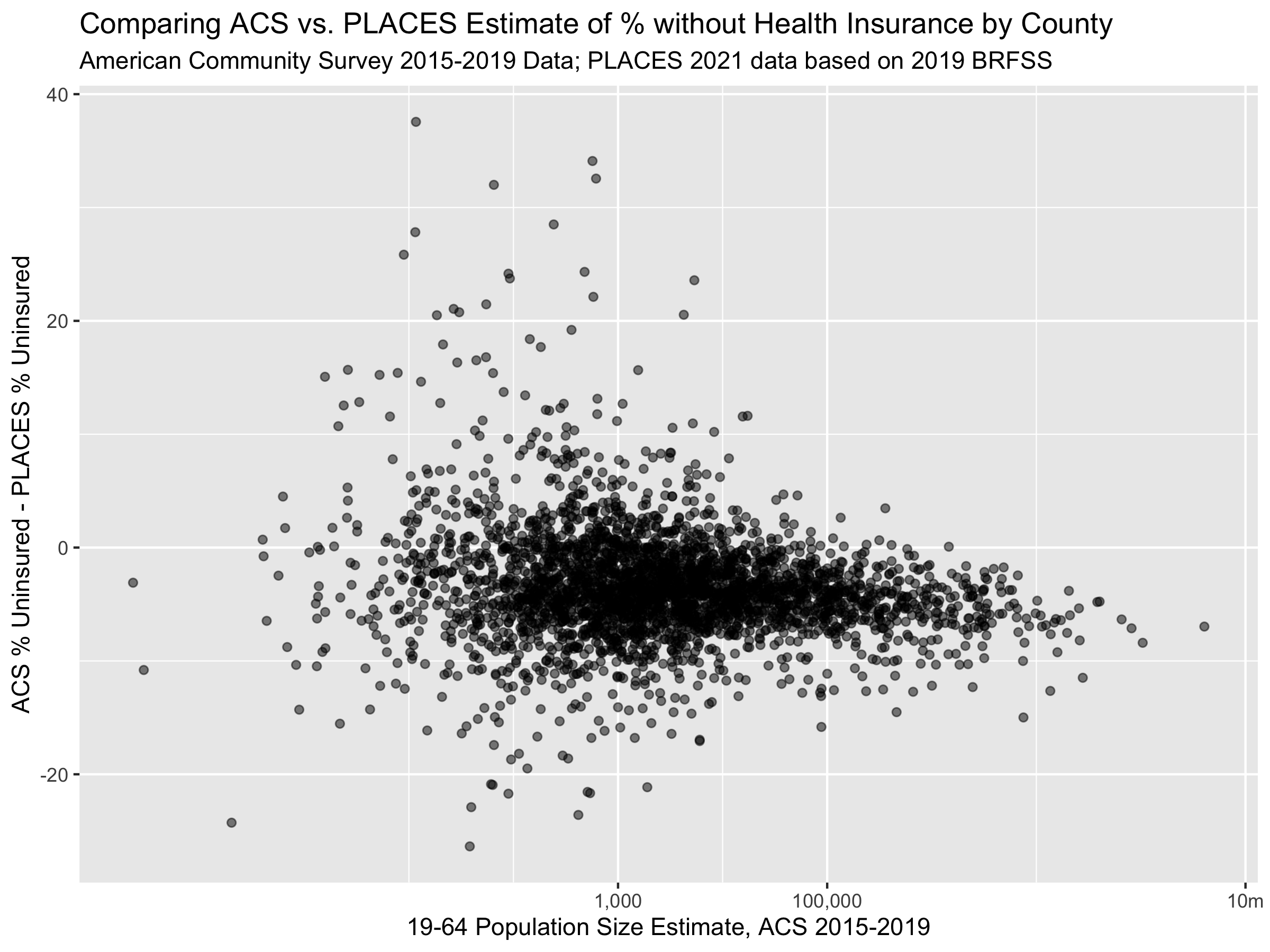
The last three figures help us to see the on-average differences between ACS and PLACES estimates of health uninsurance rates. In the histogram figure, we can see that the PLACES estimates of uninsurance are often higher than those in ACS, while the scatter-plot figures show us how this relationship changes with population size.
11.6 Adding ABSMs
variables_dict <-
tibble::tribble(
# ICEraceinc
~var, ~varname, ~description,
# total population
"B01001_001", "total_popsize", "total population estimate",
# racial composition
'B01003_001', "race_ethnicity_total", "race_ethnicity_total",
# ICEraceinc
"B19001_001", 'hhinc_total', "total population for household income estimates",
"B19001A_002", 'hhinc_w_1', "white n.h. pop with household income <$10k",
"B19001A_003", 'hhinc_w_2', "white n.h. pop with household income $10k-14 999k",
"B19001A_004", 'hhinc_w_3', "white n.h. pop with household income $15k-19 999k",
"B19001A_005", 'hhinc_w_4', "white n.h. pop with household income $20k-24 999k",
"B19001A_014", 'hhinc_w_5', "white n.h. pop with household income $100 000 to $124 999",
"B19001A_015", 'hhinc_w_6', "white n.h. pop with household income $125k-149 999k",
"B19001A_016", 'hhinc_w_7', "white n.h. pop with household income $150k-199 999k",
"B19001A_017", 'hhinc_w_8', "white n.h. pop with household income $196k+",
"B19001_002", 'hhinc_total_1', "total pop with household income <$10k",
"B19001_003", 'hhinc_total_2', "total pop with household income $10k-14 999k",
"B19001_004", 'hhinc_total_3', "total pop with household income $15k-19 999k",
"B19001_005", 'hhinc_total_4', "total pop with household income $20k-24 999k",
# poverty
"B05010_002", 'in_poverty', "population with household income < poverty line",
"B05010_001", 'total_pop_for_poverty_estimates', "total population for poverty estimates",
# median income
"B06011_001", 'median_income', "median income estimate for total population",
# crowded housing
"B25014_005", 'owner_occupied_crowding1', 'owner occupied, 1 to 1.5 per room',
"B25014_006", 'owner_occupied_crowding2', 'owner occupied, 1.51 to 2 per room',
"B25014_007", 'owner_occupied_crowding3', 'owner occupied, 2.01 or more per room',
"B25014_011", 'renter_occupied_crowding1', 'owner occupied, 1 to 1.5 per room',
"B25014_012", 'renter_occupied_crowding2', 'owner occupied, 1.51 to 2 per room',
"B25014_013", 'renter_occupied_crowding3', 'owner occupied, 2.01 or more per room',
"B25014_001", 'crowding_total', 'total for crowding (occupants per room)',
"B01001I_001", 'total_hispanic', 'total hispanic population estimate',
"B01001B_001", 'total_black', 'total black, hispanic or non-hispanic estimate',
"B01001H_001", 'total_white_nh', 'total white, non-hispanic population estimate'
)
# fetch the absms from the American Community Survey API
absms <- tidycensus::get_acs(
geography = 'county',
state = c(state.abb, 'DC'),
year = 2019,
variables = variables_dict$var)
# pivot to a wide format for renaming, dropping the margin of error data
absms %<>% select(-moe) %>% pivot_wider(names_from = variable, values_from = estimate)
# rename the columns using our rename_vars
#
# first we create a named vector, rename_vars, which has elements that are the
# acs variables we request and convenient, human readable names.
#
# then we use rename_vars with the rename function from dplyr.
# typically the rename function takes a syntax as follows:
# data %>% rename(oldname1 = newname1, oldname2 = newname2, ...)
# but in our case, we already have a named vector (rename_vars) that we
# want to use, and so to use the rename_vars named vector inside rename
# we use the injection-operator `!!`. you can learn more about the injection
# operator by running ?`!!` in your R console.
rename_vars <- setNames(variables_dict$var, variables_dict$varname)
absms <- absms %>% rename(!!rename_vars)
# calculate ABSMs
absms %<>%
mutate(
# we calculate the people of color low income counts as the overall
# low income counts minus the white non-hispanic low income counts
people_of_color_low_income =
(hhinc_total_1 + hhinc_total_2 + hhinc_total_3 + hhinc_total_4) -
(hhinc_w_1 + hhinc_w_2 + hhinc_w_3 + hhinc_w_4),
# sum up the white non-hispanic high income counts
white_non_hispanic_high_income =
(hhinc_w_5 + hhinc_w_6 + hhinc_w_7 + hhinc_w_8),
# calculate the index of concentration at the extremes for racialized
# economic segregation (high income white non-hispanic vs. low income
# people of color)
ICEraceinc =
(white_non_hispanic_high_income - people_of_color_low_income) /
hhinc_total,
prop_in_poverty = in_poverty / total_pop_for_poverty_estimates,
crowding = (
owner_occupied_crowding1 + owner_occupied_crowding2 + owner_occupied_crowding3 +
renter_occupied_crowding1 + renter_occupied_crowding2 + renter_occupied_crowding3
) / crowding_total,
prop_black = total_black / total_popsize,
prop_hispanic = total_hispanic / total_popsize,
prop_white_nh = total_white_nh / total_popsize
) %>%
select(
GEOID,
ICEraceinc,
prop_in_poverty,
median_income,
crowding,
prop_black,
prop_hispanic,
prop_white_nh
)
# join in the ABSMs data
uninsurance %<>% left_join(
select(
absms,
GEOID,
ICEraceinc,
prop_in_poverty,
median_income,
crowding,
prop_black,
prop_hispanic,
prop_white_nh
),
by = c('geoid' = 'GEOID')
)
# add quantile cutpoints to ICEraceinc
ICEraceinc_cutpoints <- Hmisc::wtd.quantile(uninsurance$ICEraceinc,
weights = uninsurance$estimate_total_19_64_population,
probs = seq(0,1,.2))
uninsurance %<>% mutate(
ICEraceinc_cut = cut(ICEraceinc, ICEraceinc_cutpoints, include.lowest = TRUE))
# reverse the factor ordering so the most advantaged group is the reference category
uninsurance$ICEraceinc_cut %<>% forcats::fct_rev()
# add cutpoints to pct in poverty
uninsurance %<>% mutate(
poverty_cut = cut(
prop_in_poverty,
c(0,.05,.1,.15,.2,1),
include.lowest=TRUE
)
)
# add cutpoints to median income
median_income_cutpoints <- Hmisc::wtd.quantile(uninsurance$median_income,
weights = uninsurance$total_popsize,
probs = seq(0,1,.2))
uninsurance %<>% mutate(
median_income_cut = cut(
median_income,
median_income_cutpoints,
include.lowest=TRUE
)
)
uninsurance$median_income_cut %<>% forcats::fct_rev()
# add cutpoints to crowding
crowding_cutpoints <- Hmisc::wtd.quantile(uninsurance$crowding,
weights = uninsurance$total_popsize,
probs = seq(0,1,.2))
uninsurance %<>% mutate(
crowding_cut = cut(
crowding,
crowding_cutpoints,
include.lowest=TRUE
)
)
# add cutpoints to proportion black
prop_black_cutpoints <- Hmisc::wtd.quantile(uninsurance$prop_black,
weights = uninsurance$total_popsize,
probs = seq(0,1,.2))
uninsurance %<>% mutate(
prop_black_cut = cut(
prop_black,
prop_black_cutpoints,
include.lowest=TRUE
)
)
# add cutpoints to proportion hispanic
prop_hispanic_cutpoints <- Hmisc::wtd.quantile(uninsurance$prop_hispanic,
weights = uninsurance$total_popsize,
probs = seq(0,1,.2))
uninsurance %<>% mutate(
prop_hispanic_cut = cut(
prop_hispanic,
prop_hispanic_cutpoints,
include.lowest=TRUE
)
)
# add cutpoints to proportion white
prop_white_nh_cutpoints <- Hmisc::wtd.quantile(uninsurance$prop_white_nh,
weights = uninsurance$total_popsize,
probs = seq(0,1,.2))
uninsurance %<>% mutate(
prop_white_nh_cut = cut(
prop_white_nh,
prop_white_nh_cutpoints,
include.lowest=TRUE
)
)
# relationship between ICE and percent without insurance in PLACES
model <- lm(
formula = pct_uninsured_18_64_places ~ ICEraceinc_cut,
data = uninsurance
)
broom::tidy(model)## # A tibble: 5 × 5
## term estimate std.error statistic p.value
## <chr> <dbl> <dbl> <dbl> <dbl>
## 1 (Intercept) 13.3 0.371 35.9 4.82e-236
## 2 ICEraceinc_cut(0.207,0.276] 1.38 0.463 2.98 2.88e- 3
## 3 ICEraceinc_cut(0.144,0.207] 2.80 0.427 6.55 6.54e- 11
## 4 ICEraceinc_cut(0.106,0.144] 5.22 0.462 11.3 5.01e- 29
## 5 ICEraceinc_cut[-0.476,0.106] 8.07 0.422 19.1 3.79e- 77
# relationship between ICE and percent without insurance in ACS
model <- lm(
formula = pct_uninsured_19_64_acs ~ ICEraceinc_cut,
data = uninsurance
)
broom::tidy(model)## # A tibble: 5 × 5
## term estimate std.error statistic p.value
## <chr> <dbl> <dbl> <dbl> <dbl>
## 1 (Intercept) 9.11 0.386 23.6 1.17e-113
## 2 ICEraceinc_cut(0.207,0.276] 1.65 0.484 3.41 6.50e- 4
## 3 ICEraceinc_cut(0.144,0.207] 3.09 0.445 6.94 4.76e- 12
## 4 ICEraceinc_cut(0.106,0.144] 5.98 0.484 12.4 2.47e- 34
## 5 ICEraceinc_cut[-0.476,0.106] 9.60 0.441 21.8 3.60e- 98
# relationship between poverty and percent without insurance in ACS
model <- lm(
formula = pct_uninsured_19_64_acs ~ poverty_cut,
data = uninsurance
)
broom::tidy(model)## # A tibble: 5 × 5
## term estimate std.error statistic p.value
## <chr> <dbl> <dbl> <dbl> <dbl>
## 1 (Intercept) 10.5 0.692 15.2 3.91e-50
## 2 poverty_cut(0.05,0.1] -0.325 0.776 -0.419 6.75e- 1
## 3 poverty_cut(0.1,0.15] 0.731 0.747 0.978 3.28e- 1
## 4 poverty_cut(0.15,0.2] 2.90 0.740 3.91 9.28e- 5
## 5 poverty_cut(0.2,1] 6.67 0.716 9.32 2.22e-20
# create a data frame with the names for each combination of the percent
# uninsured in PLACES or ACS variables in one column and each of the categorical
# exposure variables in another column
model_formulae <-
tidyr::expand_grid(
exposure = c('ICEraceinc_cut',
'poverty_cut',
'median_income_cut',
'crowding_cut',
'prop_black_cut',
'prop_hispanic_cut',
'prop_white_nh_cut'),
outcome = c('pct_uninsured_19_64_acs', 'pct_uninsured_18_64_places'))
# create a column that puts the uninsurance variables on the left-hand-side
# and the exposure variables on the right hand side
model_formulae %<>% mutate(formula = paste0(outcome, " ~ ", exposure))
# fit regression models using the robust linear model rlm method from
# the MASS package
model_formulae %<>% rowwise() %>% mutate(
model = list(
# note that you do need to have the MASS package installed;
# we aren't loading it with library() anywhere it because it causes
# conflicts with the dplyr::select function
MASS:::rlm.formula(
formula = formula,
data = uninsurance,
weights = uninsurance$estimate_total_19_64_population
)
),
model_coefs = list(broom::tidy(model, conf.int=TRUE))
)
# extract the coefficient estimates on the exposure terms
model_formulae %<>% mutate(model_coefs = list(filter(model_coefs, term != '(Intercept)')))
# unnest the model coefficients data
model_formulae %<>% unnest(cols = model_coefs)
# create a plot showing the coefficient estimates from each model -
#
# the visualization here is what's typically called a "forest plot" and shows
# the point-estimates for the coefficients and their 95% confidence intervals
# along with a dashed line at zero so we can see if the coefficients are
# significantly different from the null hypothesis (the null hypothesis being
# that the coefficient is zero).
model_formulae %>%
mutate(
term = stringr::str_remove(term, exposure), # remove the exposure string repeated in each term
term_size = as.numeric(stringr::str_extract(term, "[0-9\\-\\.e\\+]+")), # get the numeric value of each term;
# e.g. if the term was originally poverty_cut[0,0.05) then this regular expression extracts the 0
term = forcats::fct_reorder(term, -term_size)
# using the term size, we order the terms so they appear in the correct order
) %>%
ggplot(aes(x = estimate, xmin = conf.low, xmax = conf.high, y = term,
shape = outcome, color = outcome)) +
geom_vline(xintercept = 0, linetype='dashed') +
geom_linerange(position = position_dodge(width=.4)) +
geom_point(position = position_dodge(width=.4)) +
facet_wrap(~exposure, scales='free_y') +
xlab("Additional Percentage Points of Uninsurance") +
ggtitle("Modeled Effects Associated with Each ABSM",
subtitle = paste0('Models were fit separately for each ABSM')
)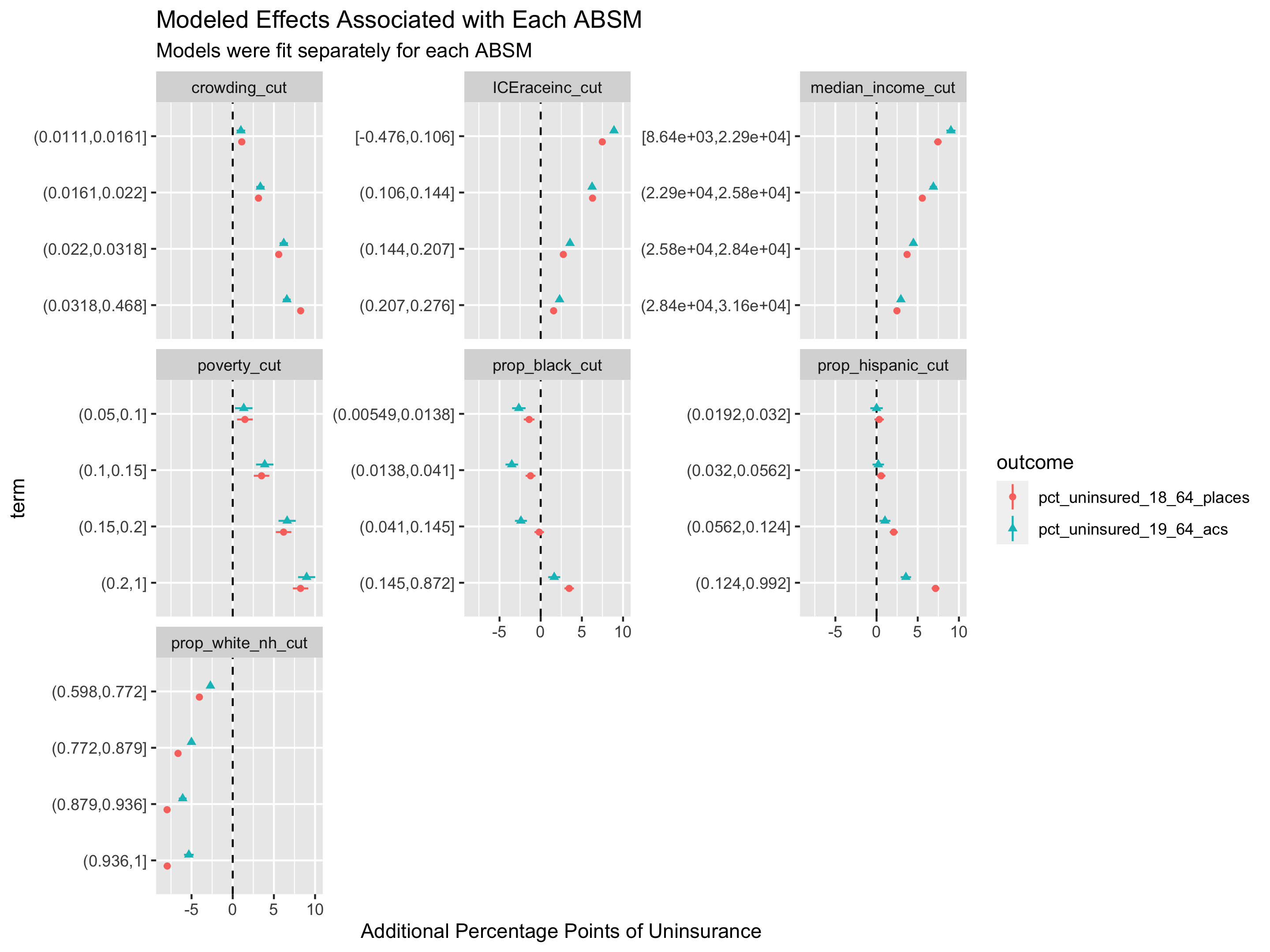
# let's take a look at some specific states
# extract the maximum uninsurance rate across both ACS and PLACES so that we can
# use it in making the color palettes consistent between the two maps for ACS
# and PLACES
max_uninsurance_rate <-
pmax(max(uninsurance %>%
filter(state_abbr == 'TX') %>% pull(pct_uninsured_19_64_acs)),
max(uninsurance %>%
filter(state_abbr == 'TX') %>% pull(pct_uninsured_18_64_places)))
# create a map showing the ACS direct estimates of uninsurance rates
acs_figure <- uninsurance %>%
filter(state_abbr == 'TX') %>%
ggplot(aes(fill = pct_uninsured_19_64_acs)) +
geom_sf(size = .1, color = 'white') +
scale_fill_viridis_c(limits = c(0, max_uninsurance_rate),
labels = scales::percent_format(scale = 1)) +
labs(fill = "Percent Uninsured (19-64)") +
ggtitle("ACS Percent Uninsurance Estimates")
# create a map showing the PLACES estimates of uninsurance rates
places_figure <- uninsurance %>%
filter(state_abbr == 'TX') %>%
ggplot(aes(fill = pct_uninsured_18_64_places)) +
geom_sf(size = .1, color = 'white') +
scale_fill_viridis_c(limits = c(0, max_uninsurance_rate),
labels = scales::percent_format(scale = 1)) +
labs(fill = "Percent Uninsured (18-64)") +
ggtitle("Places Percent Uninsurance Estimates")
# combine the two figures into one side-by-side figure
acs_figure + places_figure
# save the figure
ggsave("images/11-health-insurance-comparison/texas_comparison.png",
height = 6, width = 12)
# create a scatter plot showing the ACS vs. PLACES relationship in Texas
uninsurance %>%
filter(state_abbr == 'TX') %>%
ggplot(aes(x = pct_uninsured_19_64_acs, y = pct_uninsured_18_64_places)) +
geom_point() +
xlim(c(0, max_uninsurance_rate)) +
ylim(c(0, max_uninsurance_rate)) +
geom_abline(slope = 1, intercept = 0)
# save the figure
ggsave("images/11-health-insurance-comparison/texas_comparison_scatter.png",
height = 6, width = 6)
# florida ---
# extract the maximum uninsurance rate across both ACS and PLACES so that we can
# use it in making the color palettes consistent between the two maps for ACS
# and PLACES
max_uninsurance_rate <-
pmax(max(uninsurance %>%
filter(state_abbr == 'FL') %>% pull(pct_uninsured_19_64_acs)),
max(uninsurance %>%
filter(state_abbr == 'FL') %>% pull(pct_uninsured_18_64_places)))
# create a map showing the ACS direct estimates of uninsurance rates
acs_figure <- uninsurance %>%
filter(state_abbr == 'FL') %>%
ggplot(aes(fill = pct_uninsured_19_64_acs)) +
geom_sf(size = .1, color = 'white') +
scale_fill_viridis_c(limits = c(0, max_uninsurance_rate),
labels = scales::percent_format(scale = 1)) +
labs(fill = "Percent Uninsured (19-64)") +
ggtitle("ACS Percent Uninsurance Estimates")
# create a map showing the PLACES estimates of uninsurance rates
places_figure <- uninsurance %>%
filter(state_abbr == 'FL') %>%
ggplot(aes(fill = pct_uninsured_18_64_places)) +
geom_sf(size = .1, color = 'white') +
scale_fill_viridis_c(limits = c(0, max_uninsurance_rate),
labels = scales::percent_format(scale = 1)) +
labs(fill = "Percent Uninsured (18-64)") +
ggtitle("Places Percent Uninsurance Estimates")
# combine the two figures into one side-by-side figure
acs_figure + places_figure
# save the figure
ggsave("images/11-health-insurance-comparison/florida_comparison.png",
height = 6, width = 12)
# create a scatter plot showing the ACS vs. PLACES relationship in Florida
uninsurance %>%
filter(state_abbr == 'FL') %>%
ggplot(aes(x = pct_uninsured_19_64_acs, y = pct_uninsured_18_64_places)) +
geom_point() +
xlim(c(0, max_uninsurance_rate)) +
ylim(c(0, max_uninsurance_rate)) +
geom_abline(slope = 1, intercept = 0)
ggsave("images/11-health-insurance-comparison/florida_comparison_scatter.png",
height = 6, width = 6)
# minnesota ---
# follows the same approach as shown above for Texas and Florida
max_uninsurance_rate <-
pmax(max(uninsurance %>%
filter(state_abbr == 'MN') %>% pull(pct_uninsured_19_64_acs)),
max(uninsurance %>%
filter(state_abbr == 'MN') %>% pull(pct_uninsured_18_64_places)))
acs_figure <- uninsurance %>%
filter(state_abbr == 'MN') %>%
ggplot(aes(fill = pct_uninsured_19_64_acs)) +
geom_sf(size = .1, color = 'white') +
scale_fill_viridis_c(limits = c(0, max_uninsurance_rate),
labels = scales::percent_format(scale = 1)) +
labs(fill = "Percent Uninsured (19-64)") +
ggtitle("ACS Percent Uninsurance Estimates")
places_figure <- uninsurance %>%
filter(state_abbr == 'MN') %>%
ggplot(aes(fill = pct_uninsured_18_64_places)) +
geom_sf(size = .1, color = 'white') +
scale_fill_viridis_c(limits = c(0, max_uninsurance_rate),
labels = scales::percent_format(scale = 1)) +
labs(fill = "Percent Uninsured (18-64)") +
ggtitle("Places Percent Uninsurance Estimates")
acs_figure + places_figure
ggsave("images/11-health-insurance-comparison/minnesota_comparison.png",
height = 6, width = 12)
# wisconsin ---
# follows the same approach as shown above for Texas and Florida
uninsurance %>%
filter(state_abbr == 'MN') %>%
ggplot(
aes(x = pct_uninsured_19_64_acs,
xmin = pct_uninsured_18_64_acs_ci_low,
xmax = pct_uninsured_18_64_acs_ci_high,
y = pct_uninsured_18_64_places,
ymin = pct_uninsured_18_64_places_ci_low,
ymax = pct_uninsured_18_64_places_ci_high,
size = estimate_total_19_64_population)
) +
geom_point(alpha = .5) +
geom_errorbar(size = .1) +
geom_errorbarh(size = .1) +
xlim(c(0, max_uninsurance_rate+8)) +
ylim(c(0, max_uninsurance_rate+8)) +
scale_size_continuous(trans = scales::log10_trans(), labels = scales::comma_format(),
range = c(0.1, 3)) +
geom_abline(slope = 1, intercept = 0) +
ggtitle("Percent Without Health Insurance in Minnesota",
"95% Margins of Error Shown for Each of PLACES and ACS")
ggsave("images/11-health-insurance-comparison/minnesota_comparison_scatter.png",
height = 6, width = 9)
# wisconsin ---
# follows the same approach as above for Texas, Florida, Minnesota
max_uninsurance_rate <-
pmax(max(uninsurance %>%
filter(state_abbr == 'WI') %>% pull(pct_uninsured_19_64_acs)),
max(uninsurance %>%
filter(state_abbr == 'WI') %>% pull(pct_uninsured_18_64_places)))
acs_figure <- uninsurance %>%
filter(state_abbr == 'WI') %>%
ggplot(aes(fill = pct_uninsured_19_64_acs)) +
geom_sf(size = .1, color = 'white') +
scale_fill_viridis_c(limits = c(0, max_uninsurance_rate),
labels = scales::percent_format(scale = 1)) +
labs(fill = "Percent Uninsured (19-64)") +
ggtitle("ACS Percent Uninsurance Estimates")
places_figure <- uninsurance %>%
filter(state_abbr == 'WI') %>%
ggplot(aes(fill = pct_uninsured_18_64_places)) +
geom_sf(size = .1, color = 'white') +
scale_fill_viridis_c(limits = c(0, max_uninsurance_rate),
labels = scales::percent_format(scale = 1)) +
labs(fill = "Percent Uninsured (18-64)") +
ggtitle("Places Percent Uninsurance Estimates")
acs_figure + places_figure
ggsave("images/11-health-insurance-comparison/wisconsin_comparison.png",
height = 6, width = 12)
# this figure slightly differs from the above approach in that it includes error-bars
uninsurance %>%
filter(state_abbr == 'WI') %>%
ggplot(
aes(x = pct_uninsured_19_64_acs,
xmin = pct_uninsured_18_64_acs_ci_low,
xmax = pct_uninsured_18_64_acs_ci_high,
y = pct_uninsured_18_64_places,
ymin = pct_uninsured_18_64_places_ci_low,
ymax = pct_uninsured_18_64_places_ci_high,
size = estimate_total_19_64_population)
) +
geom_point(alpha = .5) +
geom_errorbar(size = .1) +
geom_errorbarh(size = .1) +
xlim(c(0, max_uninsurance_rate+8)) +
ylim(c(0, max_uninsurance_rate+8)) +
scale_size_continuous(trans = scales::log10_trans(), labels = scales::comma_format(),
range = c(0.1, 3)) +
geom_abline(slope = 1, intercept = 0) +
ggtitle("Percent Without Health Insurance in Wisconsin",
"95% Margins of Error Shown for Each of PLACES and ACS")
ggsave("images/11-health-insurance-comparison/wisconsin_comparison_scatter.png",
height = 6, width = 9)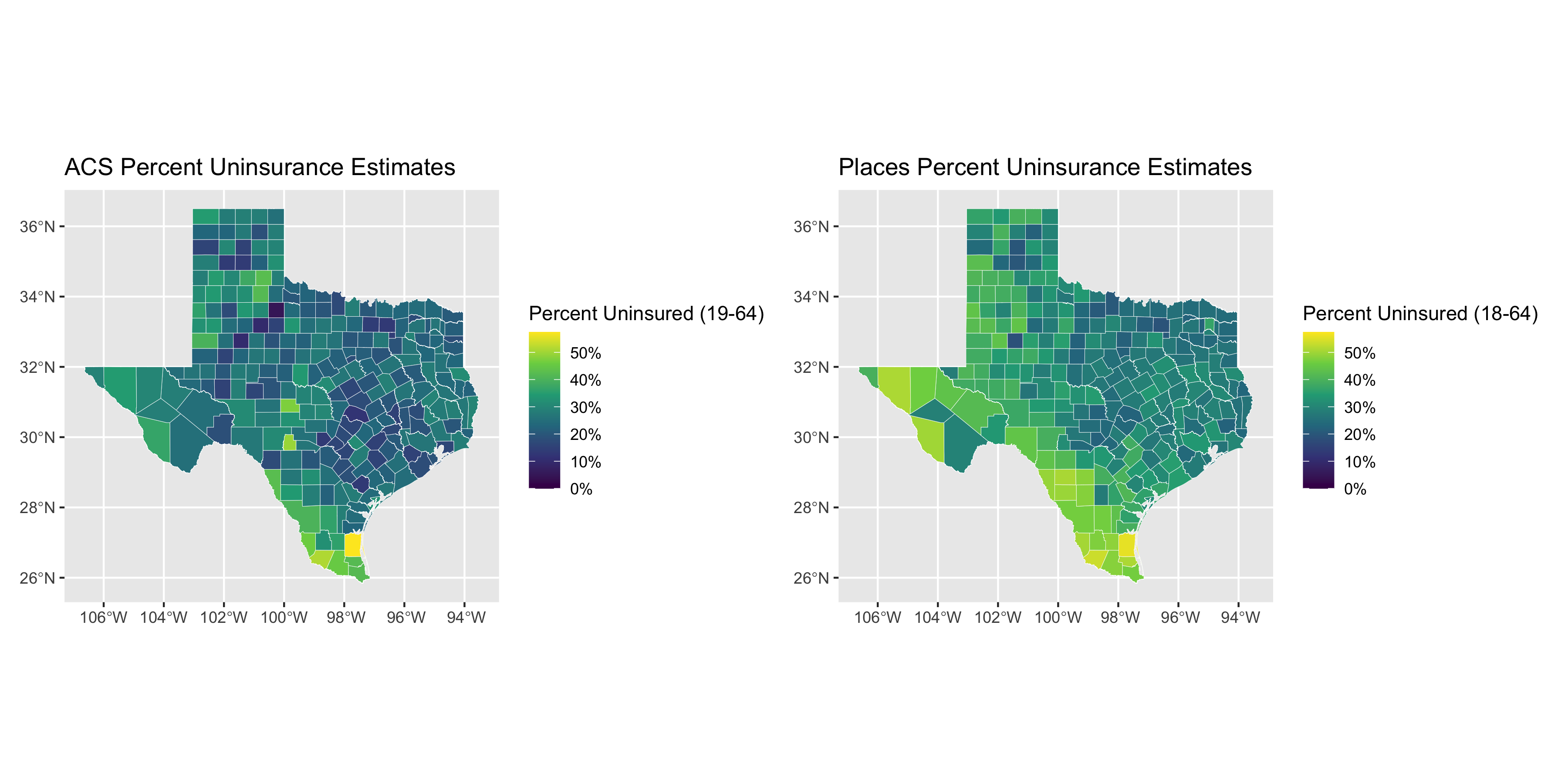

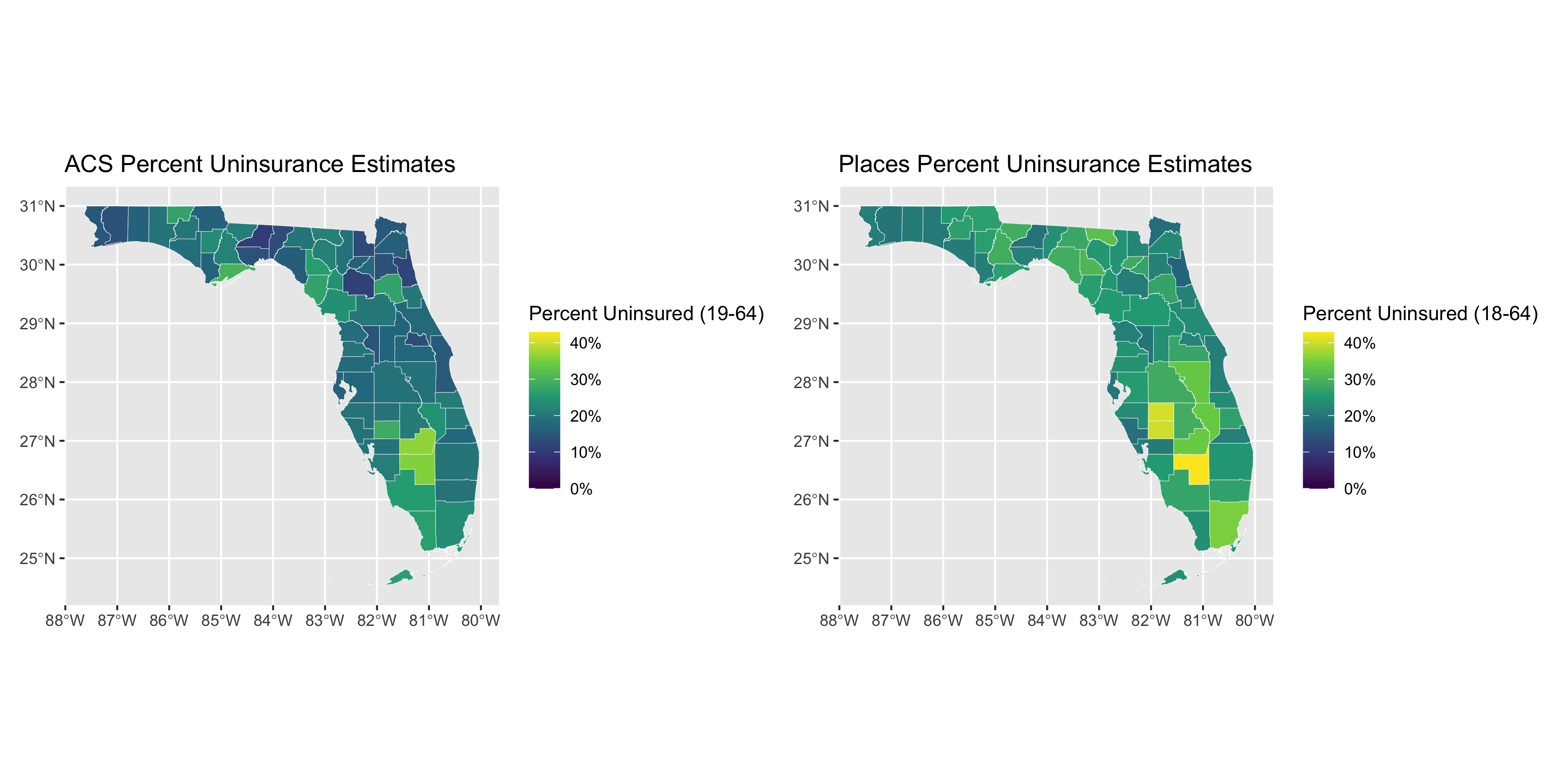
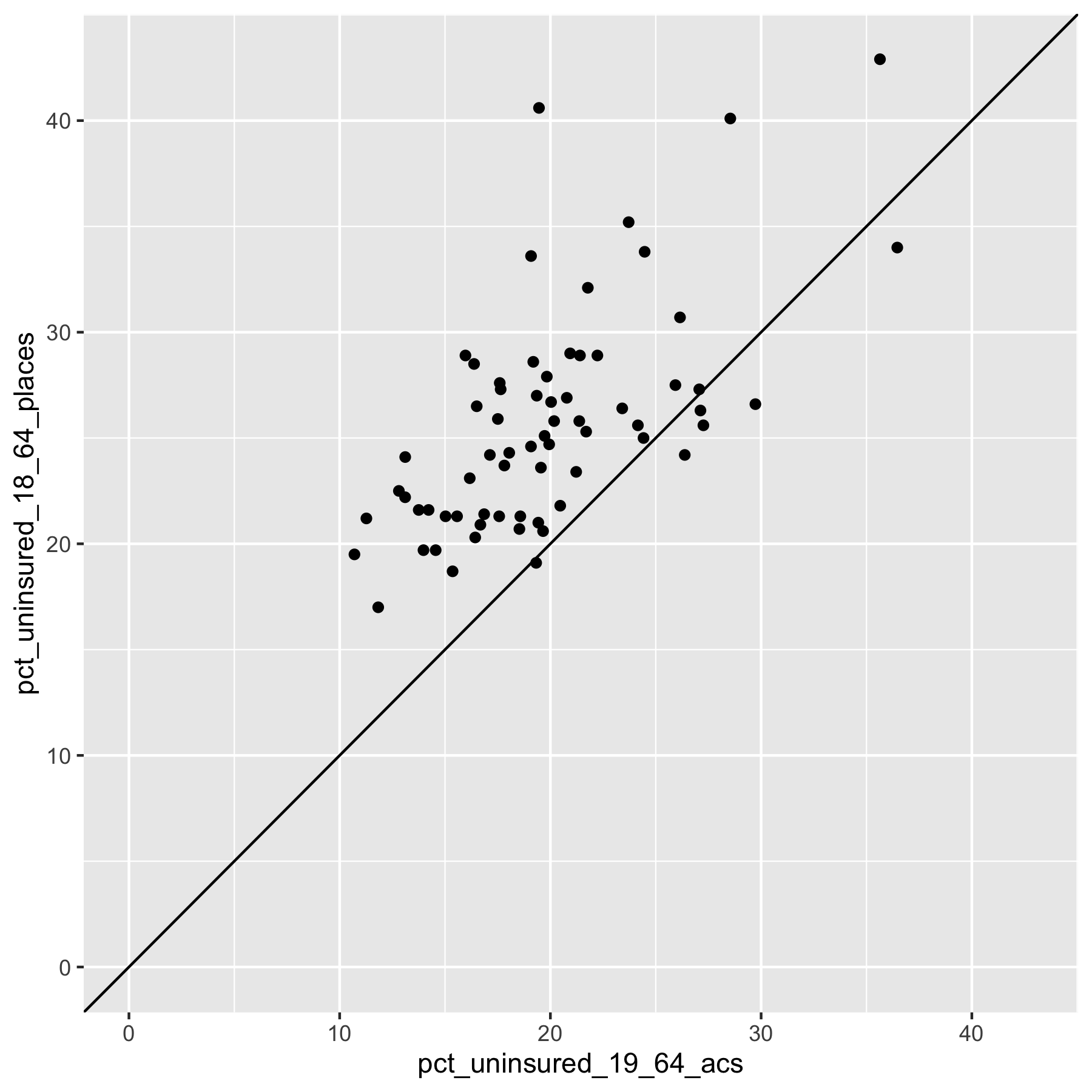
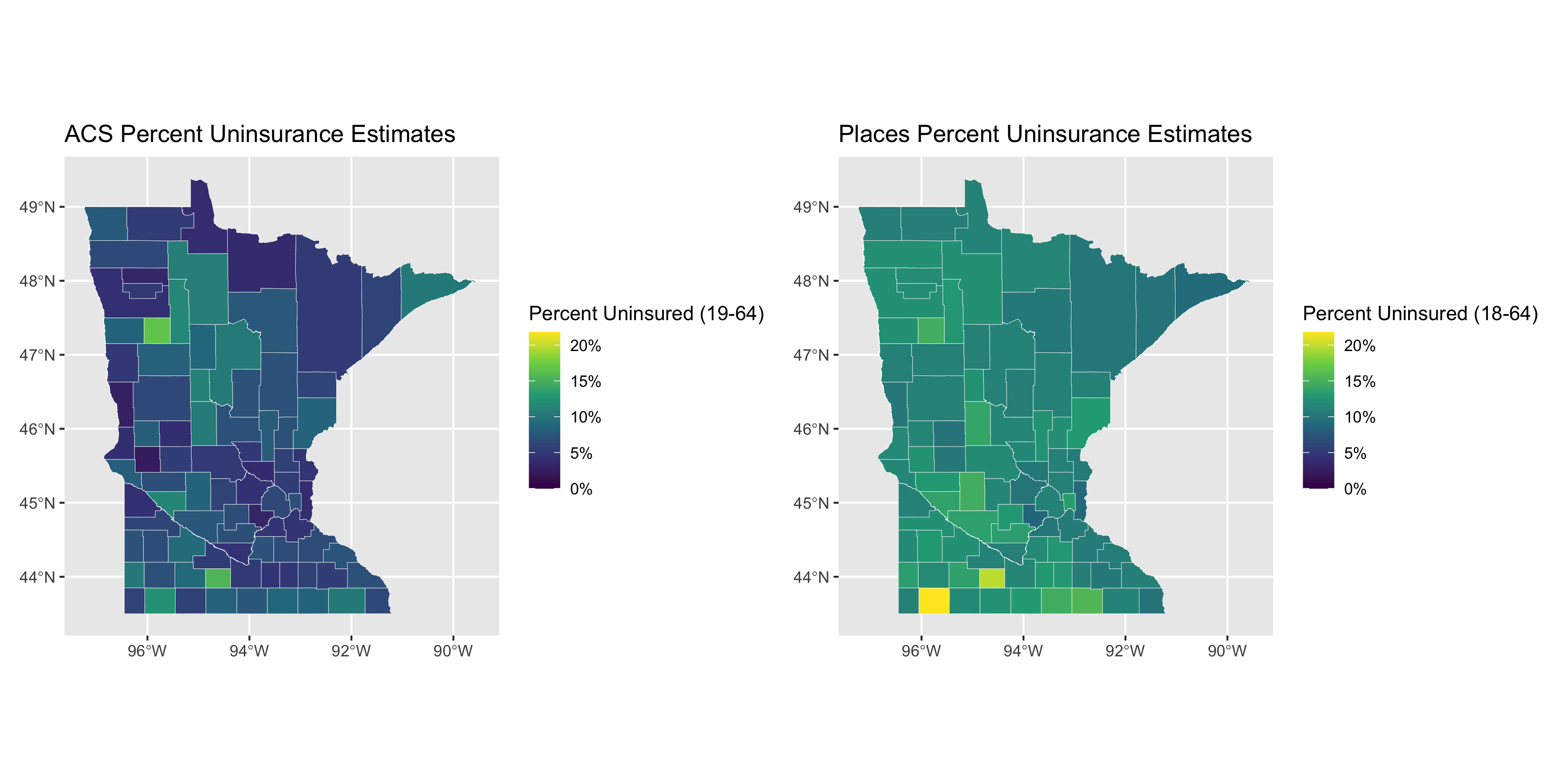

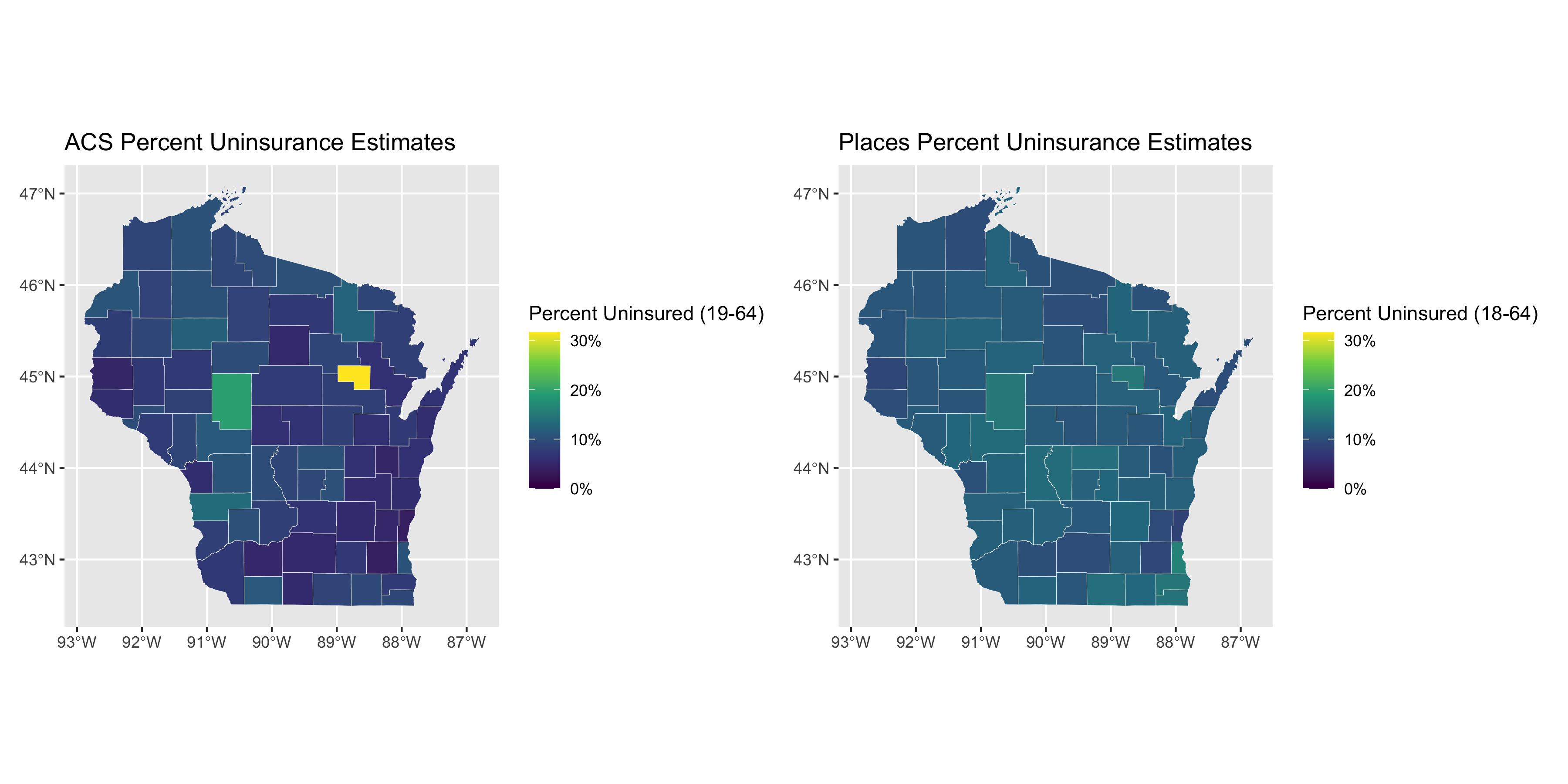
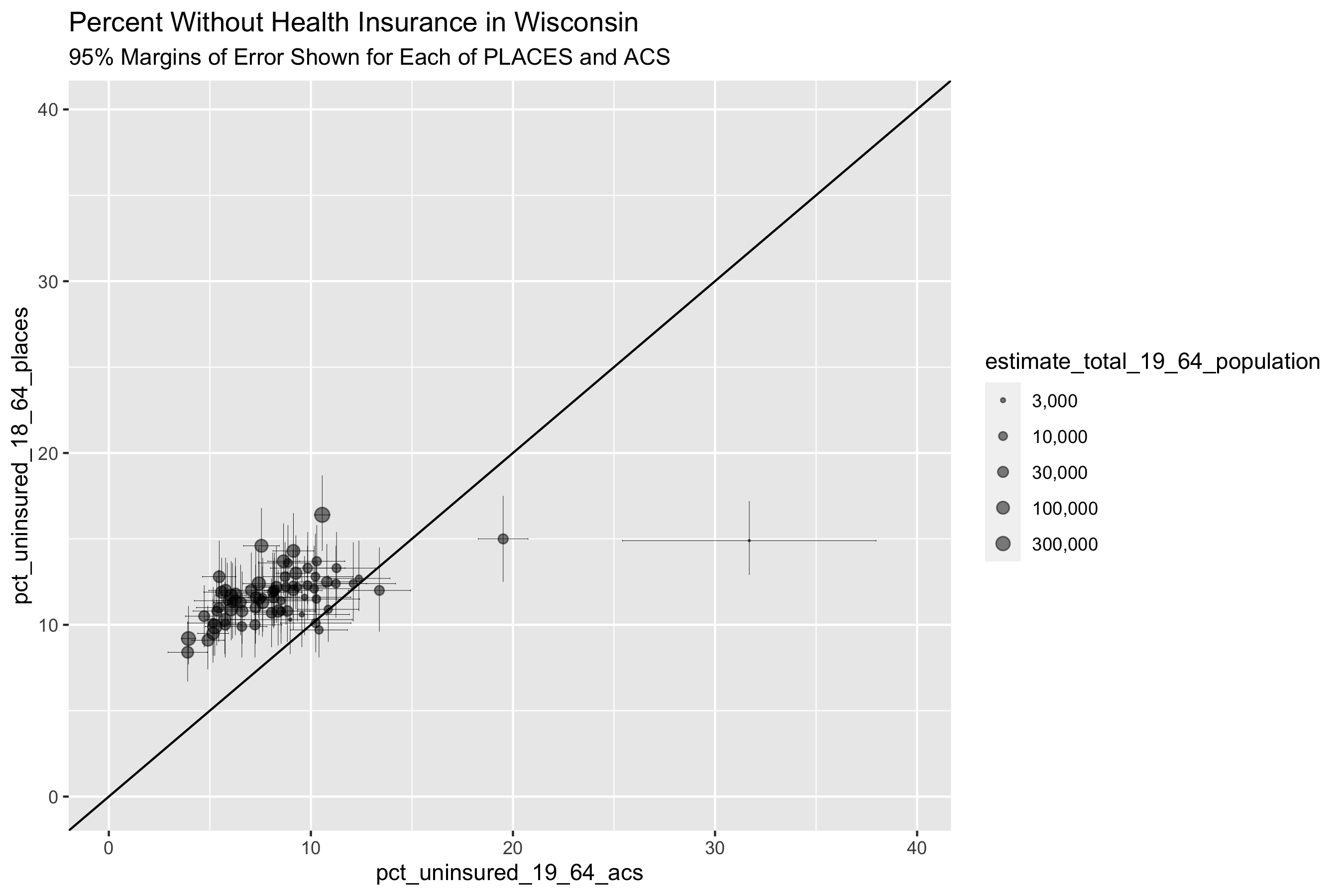
What do these graphs and analyses reveal about the value of looking at the relationships between the PLACES and ACS health insurance data in different states?
What do they show about how this relationship differs by the level of state’s overall value for health insurance coverage as well as the distribution of uninsurance?
What does this make you ask about why and how place matters?